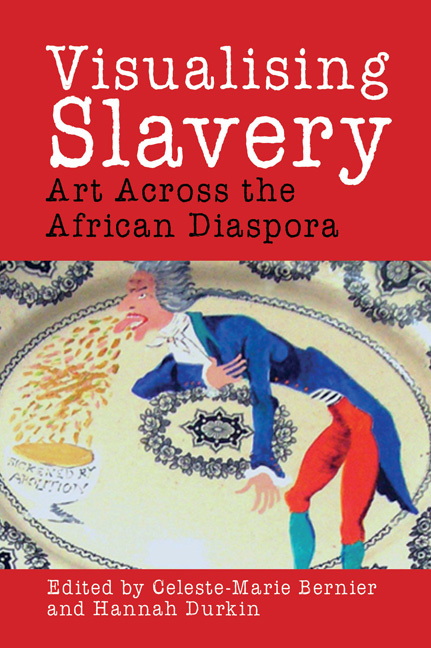Book contents
- Frontmatter
- Dedication
- Contents
- List of Illustrations
- Acknowledgements
- Introduction: ‘Inside the Invisible’: African Diasporic Artists Visualise Transatlantic Slavery
- Part I Slavery and Memory in Contemporary African Diasporic Art
- Chapter 1 Lost and Found at the Swap Meet: Betye Saar and the Everyday Object
- Chapter 2 Preserves
- Chapter 3 What Goes without Saying
- Chapter 4 Spectres in the Postcolonies: Reimagining Violence and Resistance
- Chapter 5 Strategic Remembering and Tactical Forgetfulness in Depicting the Plantation: A Personal Account
- Part II Historical Iconography and Visualising Transatlantic Slavery
- Part III African Diasporic Monuments and Memorialisation
- Part IV Contemporary Legacies in African Diasporic Art
- Afterword: Against the Grain: Contingency and Found Objects
- Notes on Contributors
- Index
- Platesection
Chapter 4 - Spectres in the Postcolonies: Reimagining Violence and Resistance
from Part I - Slavery and Memory in Contemporary African Diasporic Art
- Frontmatter
- Dedication
- Contents
- List of Illustrations
- Acknowledgements
- Introduction: ‘Inside the Invisible’: African Diasporic Artists Visualise Transatlantic Slavery
- Part I Slavery and Memory in Contemporary African Diasporic Art
- Chapter 1 Lost and Found at the Swap Meet: Betye Saar and the Everyday Object
- Chapter 2 Preserves
- Chapter 3 What Goes without Saying
- Chapter 4 Spectres in the Postcolonies: Reimagining Violence and Resistance
- Chapter 5 Strategic Remembering and Tactical Forgetfulness in Depicting the Plantation: A Personal Account
- Part II Historical Iconography and Visualising Transatlantic Slavery
- Part III African Diasporic Monuments and Memorialisation
- Part IV Contemporary Legacies in African Diasporic Art
- Afterword: Against the Grain: Contingency and Found Objects
- Notes on Contributors
- Index
- Platesection
Summary
The purpose of this chapter is to explore a number of my artworks that are concerned with history, memory and reimaging vis-à-vis the Caribbean visual archive. The artworks and chapter respond to my research into colonial visual archive material (mostly photographs) from Guyana and Trinidad (c.1900–1950s). Visual material from personal photographs from family albums, high street photographic laboratories (I refer to these as the informal archive) and state or public historical collections (the formal archive) provides a differently configured sense of the past from mainstream representations and is inextricably linked to questions of both individual memory and national histories.
My extensive archival research into this historical documentation forms the basis for my artworks Virtual Exiles (2000), Ghosting (2004) and Amendments (2007). In this chapter, I will examine a selection of individual images created for these artworks within the context of selected artworks by other contemporary Caribbean and Caribbean diaspora artists and scholars. The chapter is a reflexive commentary on colonial history as I expose narratives that evoke the aftermath and legacy of colonialism in the contemporary postcolonies of Trinidad and Guyana. The economic project of plantations – the cornerstone of colonialism devised by European powers and Western metropolitan centres – was to establish slavery (and indentureship) on an industrial scale to populate Guyana and trinidad and other Caribbean islands with the sole purpose of mass-producing raw materials including sugar, coffee, cocoa, cotton and rice. Plantation life at its heart constituted the plantation worker's body and, in particular, the female plantation worker's body as violated, racialised and non-human. The practices by which the labouring Caribbean body was visualised in early photography – an archive which documented the colonies primarily as economic projects – are fragmented and partial. The images negate, deny and substantially fail to adequately represent the presence, location and image of the female and male figure of the Caribbean plantation worker. Recognising that this was not the motivation in creating the material, in this chapter I explore my artworks as evocations and reimagings which are prompted by an impetus to address absences, provide contiguity and critique historical material in order to conjure more enriching and polyvocal representations of Caribbean history and memory.
- Type
- Chapter
- Information
- Visualising SlaveryArt Across the African Diaspora, pp. 48 - 61Publisher: Liverpool University PressPrint publication year: 2016



